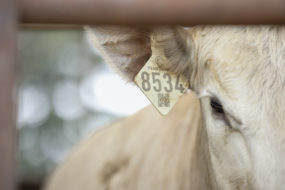When you think about prevention of disease in your cattle herd, there are a number of factors to consider when setting your calves up for success in the early stages of their lives.
It starts with preconditioning
A well-planned preconditioning program helps build a solid foundation for the future performance of a calf. A proper preconditioning program should involve quality forage or supplemental feed and nutrients, castration, dehorning, weaning, constant access to clean and fresh water, and introducing cattle to the feedbunk.
It should also include a vaccination program that protects calves against respiratory, digestive and other disease challenges, and an anthelmintic program designed to control the types of internal and external parasites that may compromise the calf’s health status and ability to convert feed to gain efficiently.
Early vaccinations
It was unheard of to vaccinate calves at an early age nearly 30 years ago, but that’s no longer the case. Research has shown by vaccinating calves at branding time or turnout, you can help ensure they’re less susceptible to becoming infected with pathogens and can have a more rapid immune response to the various pathogens that cause bovine respiratory disease (BRD.)
A recent study found only about one in four animals in feedlots are vaccinated for the more common bacterial agents associated with respiratory diseases. BRD is the No. 1 health and economic issue facing the beef industry today.
And as part of a well-managed preconditioning program, BRD prevention will help generate the best bottom line in an environment that demands prudent risk management practices from all angles of production.
BRD attacks the animal’s respiratory system through bovine viral diarrhea virus, infectious bovine rhinotracheitis, parainfluenza 3, bovine respiratory syncytial virus and Mannheimia haemolytica.
BRD can be transferred through fluids (e.g., nose-to-nose contact, shared water and feed) or through the air. Respiratory viruses and pathogens can suppress the calf’s immune system, making it more susceptible to secondary bacterial infections.
Waiting to vaccinate calves until weaning could be costly. It can leave calves unprotected during the summer months, when they are susceptible to summer pneumonia. Studies have shown calves impacted with respiratory disease prior to weaning are, on average, 36 pounds lighter at weaning than their herdmates.
With today’s cattle prices, it’s important for producers to maximize gain in order to sell heavier calves.
Vaccinating early can also help reduce calf stress. Calves are challenged with many stressors during weaning including castration, transportation, disease challenges, commingling, dietary changes and more.
Adding vaccination at this time can increase stress levels in calves, so it’s recommended to focus on giving vaccines at low-stress times, like during spring turnout when calves go back out to pasture with their mothers. This will give their immune system the opportunity to work at optimum levels.
Moreover, research studies have demonstrated calves as young as 5 to 6 weeks old can be effectively immunized against bovine viral diarrhea virus. Bovine viral diarrhea virus Type 1b is the most prevalent strain in the U.S., so make sure the vaccine you choose offers solid protection against it.
Good management practices
While vaccination can aid in preventing disease, it cannot replace good management practices. How we manage our animals is the key to success: Provide animals with a comfortable, clean pen or pasture space and ensure they’re receiving the proper nutrition and have access to plenty of clean water.
It’s also important to pay attention to cattle-handling techniques to keep the cattle calm and stress-free as possible. When administering vaccines, be sure to read the label and give the correct dosage. Last, it’s vital to keep good records of cattle vaccinations and other animal health applications.
Consult your veterinarian
Work with your local veterinarian to develop a vaccination and overall animal health plan best suited for your particular environment. Along with BRD and bovine viral diarrhea virus protection, the plan should incorporate a parasite control program, which includes a dewormer that provides persistent control of the particular parasites known to infest the herd and pastures. ![]()
PHOTO: Research is proving an advantage to vaccinating calves well before weaning. Photo courtesy of Boehringer Ingelheim.
References omitted but are available upon request. Click here to email an editor.

-
Jody Wade
- Professional Services Veterinarian
- Boehringer Ingelheim
- Email Jody Wade







